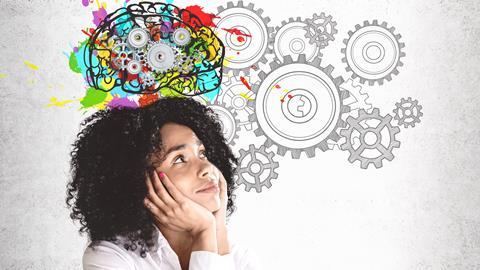A high-ranking judge once told me he sketched portraits of barristers and witnesses in the margins of his notebook. Aside from confounding traditional advice to advocates about watching the judge’s pen to ensure he had finished writing down evidence, such an admission might initially give rise to concern about a lack of concentration and involvement in the case. In fact, research shows that being creative may be one of the best things we do to keep our lawyers’ brains in full working order. Being creative impacts on our mental wellbeing, as well as the quality of our work.

Creativity is often seen as the domain of the arts: music, painting, acting, writing and the like. In fact, creativity is simply the act of creating new combinations. Being creative is having trained your brain to do that easily. Steve Jobs famously said: ‘Creativity is just connecting things. When you ask creative people how they did something, they feel a little guilty because they didn’t really do it, they just saw something. It seemed obvious to them after a while. That’s because they were able to connect experiences they’ve had and synthesize new things.’
You do not need innate talent to be creative and you do not need to make masterpieces. Any creativity expands our brains in ways that greatly benefit our performance as lawyers. Parvrita et al, writing in the Indian Journal of Psychiatry in 2007, reviewed a number of studies on creativity and found that highly creative individuals showed more cognitive flexibility, interest, accuracy in communication and intellectual curiosity. Training ourselves to think creatively through a hobby allows us to come to work with a brain primed to find creative legal solutions for our clients.
Like most skills, the ability to be creative comes from practice. Certainly we use creativity in law. Just putting facts together with little used statutory provision to get a good case is creative. However, there are two good reasons why, as part of our practice of law, we should make time to practise another creative activity, however, easy or small. In fact, the more it feels like play and not work the better.
The first reason is that true creativity has four characteristics:
- The product has novelty and value either for the thinker or the culture;
- The thinking is unconventional;
- It is highly motivated and persistent or of great intensity; and
- The problem was initially vague and undefined, so that part of the task was to formulate the problem itself.
Once the activity of combining fact plus law is routine it ceases to be creative in this sense, but still demands the abilities and cognitive flexibility that creativity teaches us. Doing something novel outside of law – whether that’s playing the guitar, writing stories for your kids, or designing and building a new patio in the garden – alters our brain structure for the better. A study in the Creativity Research Journal by Hopper and Kyle found that subjects who were creative had a better connection between the two hemispheres of the brain.
Recent neuroscience has shown that the two sides of the brain do not operate in isolation but communicate between each other via the corpus callosum. Dr Jeff Anderson of the University of Utah carried out a study of more than 1,000 participants which revealed that, while activity was sometimes higher on one side or the other in certain critical regions, on average both sides of the brain were essentially equal in their activity. The study’s lead researcher explains: ‘It’s absolutely true that some brain functions occur in one or other side of the brain. Language tends to be on the left, attention more to the right, but people don’t tend to have a stronger left- or right-sided brain network. It seems to be determined more by connection.’
Engaging in creative activity can enhance that connection and thus literally make our brains work better by giving us access to more functioning. The connection does not just work with the activity chosen but then exists as a resource available to us in our work. For example, one study looked at people who had some theatre training and found that they were left with improved word and listening recall.
The second justification for out-of-work practice is that research also shows that stress, time constraints, perfectionism and fear of failure dampen down creativity. We need to find time to play like children, to immerse ourselves in a pleasurable activity just for the joy of it. It has long been known that the smallest of creative activities can boost a sense of mental well-being – and there are many theories as to why that might be. Heather Stuckey and Jeremy Nobel, summarising a literature review in the American Journal of Public Health, found that ‘creative engagement can decrease anxiety, stress, and mood disturbances’. Their explanation was that allowing ourselves truly creative expression enables us to focus on ‘the holistic person’ and that through creativity, expression and imagination we ‘find our identity’.
To truly experience wellbeing, we need to be fully rounded people with a sense of what our life means and the ability to find a time way from the stress and demands of work.
Creative activity of the simplest kinds allows us first to refresh from the demands of the job. It removes us from the stress and gives us access to ‘flow’ – the state of deep concentration where we lose sense of time and the world outside our activity. In addition, by continued practice, creativity grows our brains in a way that gives us skills we need, which in turn can make the job less stressful.
All this research demands of us that we rethink what ‘work’ is; and what ‘CPD’ is and consider including in those definitions time to train our brains with creative play. That might be playing with paint or strumming a guitar or making model planes – whatever floats your (handmade) boat.
Helen Conway is a coach, trainer, writer and retired judge (www.helenconway.com)
































No comments yet